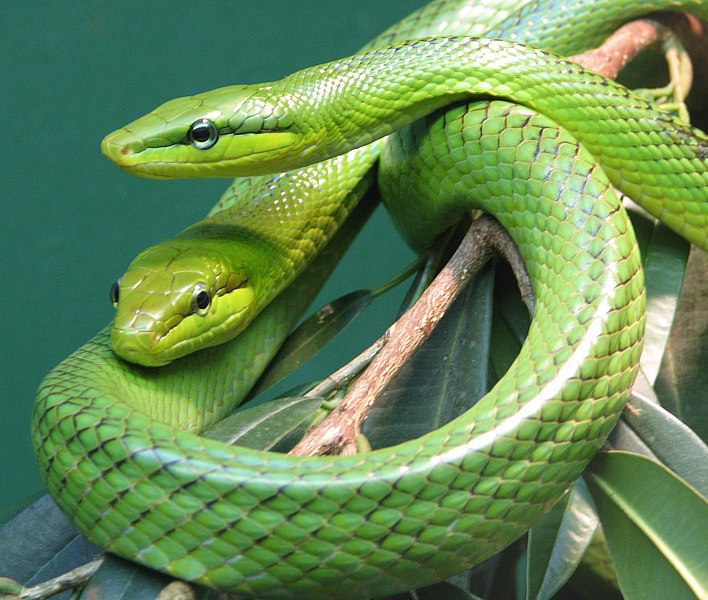Please see Part I of this article for further information.
Handling and Enrichment
 Red-tailed ratsnakes are best suited as exhibit animals. Most do not hesitate to bite when approached, and fight vigorously when restrained. Some may become moderately tame, but such individuals must be watched closely and not allowed in the vicinity if one’s face or near children (or, obviously, your parakeet!).
Red-tailed ratsnakes are best suited as exhibit animals. Most do not hesitate to bite when approached, and fight vigorously when restrained. Some may become moderately tame, but such individuals must be watched closely and not allowed in the vicinity if one’s face or near children (or, obviously, your parakeet!).
Naturalistic terrariums suit red-tailed ratsnakes well, but it can be difficult to remove them from among vines and branches. A tall cage that allows you to clean while the snakes remain safely overhead will go a long way in reducing stress on both the snakes and yourself (not to mention wear and tear on your skin!).
They are very alert – “scenting” the cage with novel odors – i.e. a snake or lizard shed, or an egg – will keep the snakes occupied and provide a peek into their foraging behaviors (in zoo circles, this long-known practice is now termed “enrichment” and is currently very much in vogue).
Breeding
Red-tailed ratsnakes under my care and housed together in pairs have bred throughout the year without being subjected to a variation in temperature or humidity levels. Others have bred after being subjected to a 3 month period at 70 F, during which time they had access to a basking site of 76 F. Given their wide distribution in the wild, I suspect that these snakes are quite adaptable in this regard, or that populations vary in their breeding biology.
Most females that I have kept produced 2-3 clutches per year, with one female laying 3-4 times each year for a period of 8 years or so. Gravid females seek secluded, moist sites in which to lay their eggs; damp sphagnum moss within a cave, flower pot, or cork bark retreat is ideal. Some individuals seem to prefer elevated nest sites; perhaps in the wild eggs are sometimes deposited in tree hollows and similar situations.
Please see “Reproduction” in Part I of this article for further details.
Jansen’s or Sulawesi Black-Tailed Ratsnake
The red-tailed ratsnake’s closest relative, and, per recent taxonomic changes, the only other member of the genus Oxycephala, is the Jansen’s ratsnake, also known as the Sulawesi black-tailed ratsnake, G. jansenii.
Limited in distribution to Sulawesi, Indonesia and some small nearby islands, this gorgeous snake is variably colored in black-flecked olive or tan, and sports a black tail. Those on Sulawesi are heavier-bodied than typical red-tailed ratsnakes, and are said to spend a good deal of time on the ground. Specimens from Salayar, an island south of Sulawesi in the Flores Sea, are pure black and quite striking in appearance. Thinner in build than their relatives on Sulawesi, they are, like red-tailed ratsnakes, highly arboreal.
Although not widely available at this point, Jansen’s ratsnakes are prized by collectors and will likely become established in the trade in time.
Further Reading
An interesting review of the 55 snake species that inhabit Sulawesi is posted at http://www.seh-herpetology.org/files/bonnensis/035_DeLang.pdf.
The range of the Taiwan beauty snake overlaps with that of this species, and their husbandry needs are similar. Please see my article The Natural History and Captive Care of the Taiwan Beauty Snake for further information.
Image referenced from Wikipedia.
 That Reptile Blog – Reptile, Amphibian and Exotic Pet Care and Information
That Reptile Blog – Reptile, Amphibian and Exotic Pet Care and Information


